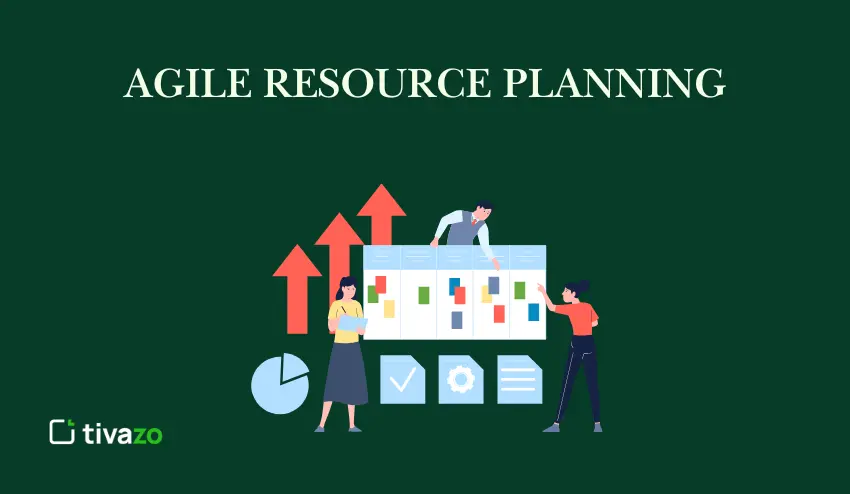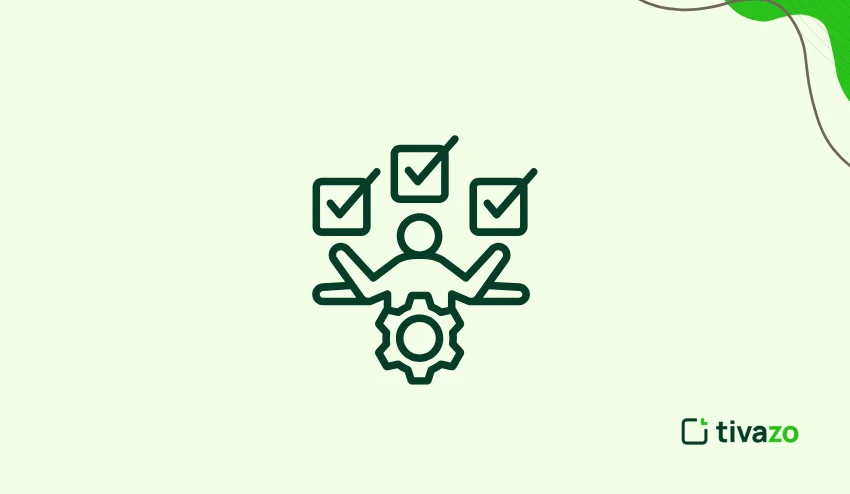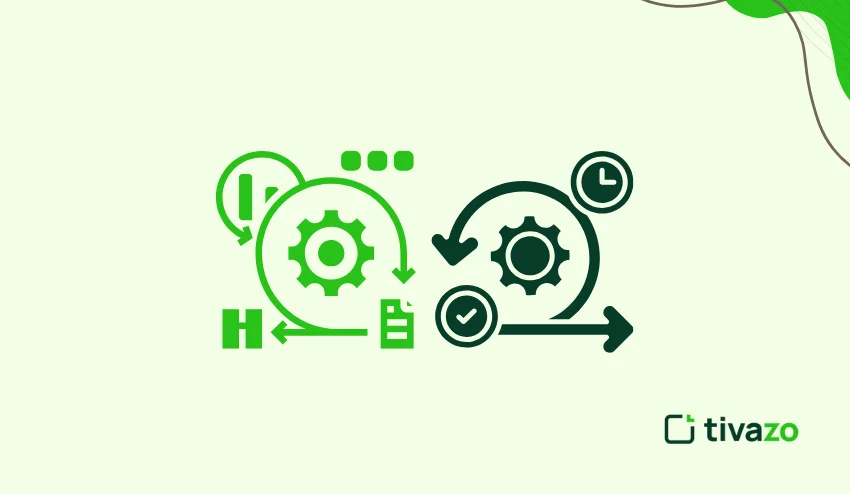For a project, resource planning can make or break it. It can be a monumental job to assign the right people to the right tasks at the right time, particularly in fast-moving scenarios where priorities change. Agile resource planning helps you respond with flexibility, transparency, and continuous adaptation to rapidly deliver change, responding to changes without sacrificing delivery.
With traditional resource planning, fixed schedules and rigid roles for team members guide the process. Agile resource planning evolves around a dynamic allocation based on skills, capacity, and priorities for a project. Rather than waiting for set intervals, teams work in short cycles, regularly looking at workloads and seeking to balance assignments as needed to ensure the team is being as efficient and generating maximum value.
This guide will help you find the principles, processes, approaches, and best practices of agile resource allocation. It will be a useful resource to small teams managing a new product or service, or those companies that are leading a multitude of projects, or even teams and organizations trying to navigate a hybrid agile/waterfall environment. You will be provided with clear, actionable ways to use the principles, examples, and various practical tools to make the most out of how you allocate and manage your resources.
What Is Agile Resource Planning
Agile resource planning is the dynamic allocation and management of team resources to align work to project priorities and organizational goals. Resources are managed and allocated based on flexibility, adaptability, and constant reassessment rather than strict structures or fixed roles. Since agile project teams work in iterative planning cycles, they can react quickly to changes to be sure that the resources are being utilized effectively.
While traditional resource planning requires teams to define long-term task assignments for resources, agile resource planning focuses on skills rather than roles. Resources are constantly reassigned, progress is made incrementally, distractions are eliminated, and bottlenecks are addressed as they happen. This method also allows maximum productivity while not overburdening individuals.
In the real world, agile resource planning uses Kanban boards, sprints, and planned capacity dashboards. Teams manage the consistency of work by constantly reviewing team allocations, forecasting team time needed, and adjusting as work evolves. The goal is aligned, sustainable delivery of value over time with a balanced team.
Agile Resource Planning vs. Traditional Resource Planning
Agile resource planning, compared to traditional resource planning, has different approaches, flexibility, and emphasis. Traditional planning involves forecasting for an extended future attributable to fixed roles and timelines emphasizing predictability and/or details upfront in planning horizons (timescales) that project requirements will not change. This works very well if you have a clearly defined project scope that does not change over time. Conversely, this approach will become unwieldy in fast-moving environments where priorities frequently change.
Agile resource planning, in contrast, emphasizes collaboration, responsiveness, and incremental capacity development. In an agile capacity planning environment, the team emphasizes skills, projects workloads each sprint or iteration, and actively collaborates on an analyst basis to adjust workloads and resources to changing needs that arise. The collaborative analysis process aims to minimize bottlenecks, optimize team productivity, and appropriately allocate resource capacity to the wants and needs of the customer in each moment, and continually to the highest value work.
Comparison Table: Traditional vs Agile Resource Planning
| Aspect | Traditional Resource Planning | Agile Resource Planning |
|---|---|---|
| Planning Horizon | Long-term, fixed schedule | Short-term, iterative sprints |
| Flexibility | Low; hard to change | High; adjusts to shifting priorities |
| Role Definition | Fixed roles and responsibilities | Skills-focused, cross-functional teams |
| Risk Management | Predictive, assumes stable requirements | Adaptive, adjusts to emerging risks |
| Delivery Focus | Complete project at end | Continuous incremental delivery |
| Tools | Gantt charts, spreadsheets | Kanban boards, capacity planning tools |
| Team Collaboration | Limited, hierarchical | High, frequent communication |
Agile resource planning is best suited in situations with constant change and the need for a quick response. While traditional can still be useful for very predictable projects, the best results for modern project environments are often a hybrid of flexible and structured planning.
Key Principles of Agile Resource Planning
Agile resource planning rests on a set of key principles that help teams remain flexible, effective, and focused on putting effort towards moving the project towards its goals. These principles guide teams on how best to manage resources in a fast-paced iterative mode.
1. Iteration and Flexibility
Work is organized in iterations (or sprints) to provide a work system the flexibility to assign resources, when necessary, to accomplish new highest priority work. An iteration-based work system allows the team to always focus on delivering the highest value work and respond to emerging problems that may change priorities in the overall plan.
2. Self-Organizing, Multidisciplinary Teams
Agile recognizes work teams to be comprised of enfranchised multi-disciplined groups. Applications of agile methods breaks down functional job roles and affirm that a team works based on the skills and interests of the members in a collective team context to deliver the best work. Team members may discharge their job functions in the context of carrying out their work in a productive way that promotes improved flexibility in positional ownership of work, while mitigating dependency bottlenecks.
3. Ongoing Collaboration and Communication with Stakeholders
Stakeholders who provide feedback on a regular basis help ensure that resources are allocated to resulting outcomes that are relevant to the evolving needs of the business. Frequent check-ins and transparent communication support teams in making timely decisions and in evaluating the need to adjust priorities throughout the course of the work.
4. Continuous Delivery of Value
Agile teams do not wait to deliver resulting outcomes until the end of the entirety of a project; rather, they emphasize continual and incremental wins. Resources are allocated to tasks that yield the most immediate value, enabling sustained momentum (activity) and quantitative results throughout the project.
These principles provide a complete model enabling teams to balance workloads, respond to change, and optimize efficiency. These principles also provide a framework for advanced techniques, tools, and best practices in regard to agile resource planning.
The Process of Agile Resource Planning
Agile resource planning utilizes a process-based plan that is structured but enables flexibility in aligning resources that suit the evolving nature of a project. The process is inherently iterative but can be described in five simplistic phases: Envision, Speculate, Explore, Adapt, and Close.
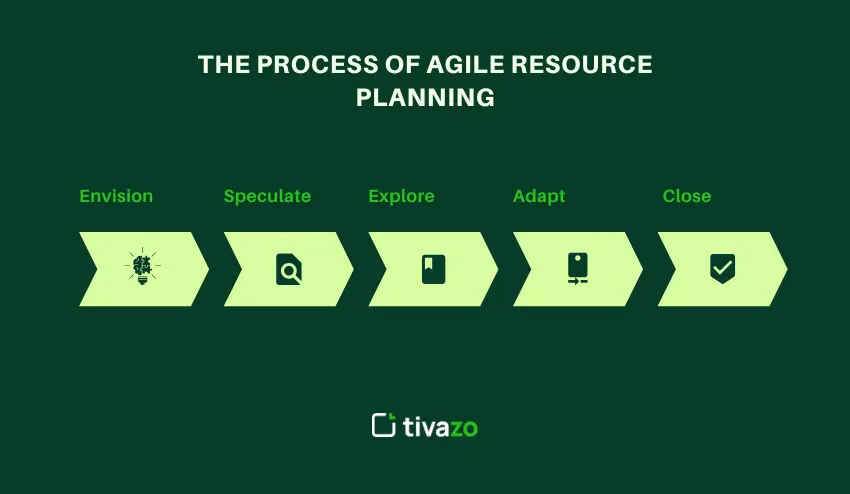
Envision
At this stage, the emphasis is on defining the vision, objectives and high-level requirements of the project. The team identifies key resources, skills and capacities needed to support the project’s objectives. Identifying constraints and/or may issues early on will help inform planning decisions in the subsequent steps.
Speculate
The speculative phase involves teams making a high-level plan for resourcing through a series of sprints or iterations. Low-resolution planning establishes how resourcing is expected to be allocated. Teams prioritize work based on expected value, with the understanding that adjustments or changes may occur as the project progresses.
Explore
In the explore phase, teams can now actively execute the work planned in iterations. The workload and resourcing is continuously monitored throughout the iteration. Regular stand-ups, Kanban boards, and tracking within sprints can help the team visualize where the work is tracking, bottlenecks to address, and make minor adjustments in real time.
Adapt
The adapt phase is essential to agility. Teams reflect on quantifiable performance measures, examine stakeholder feedback, resource allocation, and other assessment metrics. The adjustments to performance, tasks, or timelines depend on what has emerged and what may be possible in the future.
Close
Once the project or iteration reaches closure, review the outcomes, document lessons learned, and identify potential improvement opportunities for the next planning cycle. Teams review, revise, and/or edit templates, checklists, and resource allocation frameworks supporting continual improvement.
Low Res vs. High-Res Planning
An agile resource planner requires some long-term (low-resolution) plans to respond to short-term (high-resolution) planned sprints and resources that would be available. Low resolution planning may provide a forecast and overview of the overall product roadmap, while high resolution can help provide for responsive allocation per sprint and in-the-moment shifting of resources.
Key Techniques for Agile Resource Planning
Successful agile resource planning is dependent on practical techniques that help to manage workload, balance capacity, and maintain transparency across the project life cycle.
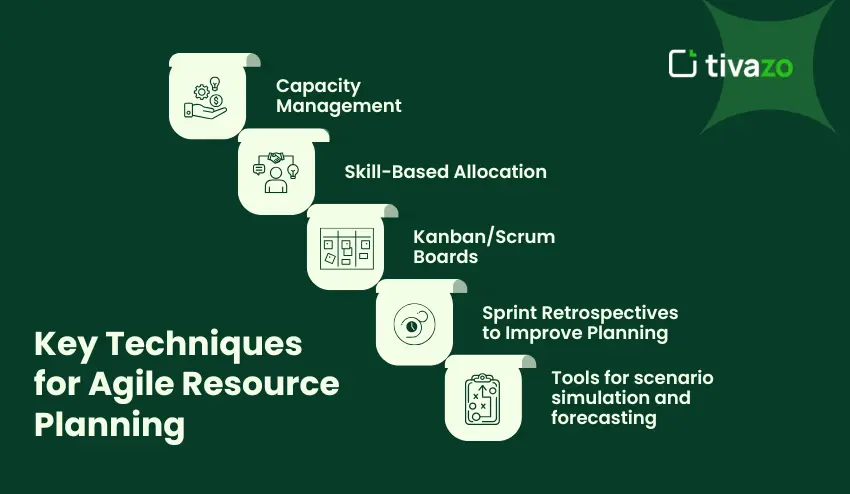
1. Capacity Management
Monitoring in real time for team members’ workload and availability provides assurance that people are not overallocated. Agile teams tend to monitor hours, task assignments, and resource use within dashboards, Kanban boards, or capacity planning tools as a methodology for capacity management. Having visibility into these things will enable project managers to adjust as needed.
2. Skill-Based Allocation
As opposed to simply assigning based on the role assigned, agile resource planning is completed with the primary focus on capability. Teams identify who has the knowledge to successfully carry out the task in an efficient manner, and if project timelines allow, they will trade responsibilities, allowing for knowledge transfer and flexibility, while fostering team proficiency.
3. Kanban/Scrum Boards
Visual management tools (Kanban/Scrum boards) add a level of transparency to resource allocation. Teams and managers can visually see the progress of tasks and adjust workload based on team members’ effort while identifying bottlenecks.
4. Sprint Retrospectives to Improve Planning
Regular retrospectives allow the team to reflect on previous sprints, discuss the team’s performance, and take action to make informed changes in the team’s resource planning. The learnings from retrospectives help make better forecasting and resource allocation in future iterations.
5. Tools for scenario simulation and forecasting
There are advanced tools that allow teams to “what if” scenarios, forecasting the impact of changes to priorities and resource availability. The proactive approach involves identifying potential bottlenecks, overcommitting, and planning based on data.
These techniques combined keep teams agile, provide optimum use of resources, and ensure valuable delivery of the team in the sprint.
Best Practices for Agile Resource Planning
To be most effective and to remain flexible, agile teams should engage in several good practices for project resource planning and resource management.
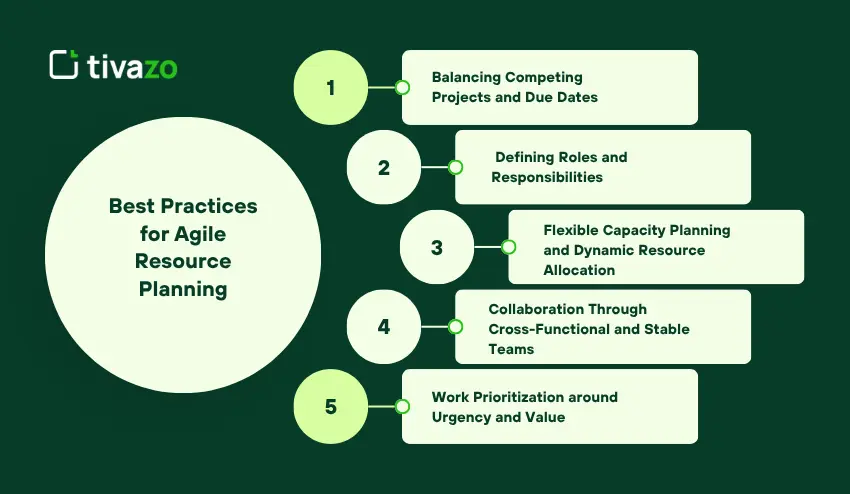
1. Balancing Competing Projects and Due Dates
Teams will typically have a host of projects occurring simultaneously, each with its own set of priorities. By implementing a regular review cycle and adjusting the allocation of resources, you can ensure that projects do not fall between the cracks while also allowing for expedited delivery of projects without sugar-coating the workload on any one team member.
2. Defining Roles and Responsibilities
Even when working with cross-functional teams, clarity matters. Using a hybrid RACI (Responsible, Accountable, Consulted, Informed) will help to clarify roles and responsibilities while also keeping teams agile, ensuring accountability while still being flexible.
3. Flexible Capacity Planning and Dynamic Resource Allocation
The assignment of project members and resources should be agreed upon based on the availability of the resource and skill set, not assigned based on a pre-determined schedule. In agile project teams, team members constantly reassess the workload every sprint and allocate resources based on the delivery urgency of the priorities involved.
4. Collaboration Through Cross-Functional and Stable Teams
Good communication across teams fosters dependency management, knowledge transfer, and minimizes bottlenecks. Agile resource planning works extremely well with stable teams that learn the strengths of the workforce while being adaptable to moving priorities.
5. Work Prioritization around Urgency and Value
Resource allocation should relate to the business value and goals of the project. Work that would be most impactful in the timeframe will get priority over other, less critical work.
Challenges and Solutions
Involvement of Agile resource planning generates flexibility and adaptability, but there are challenges associated with this practice. By being aware of the challenges one might face and proactively reacting to them, one can assist in optimizing resource planning so the project can continue smoothly.
1. Long-Term Forecasting
Forecasting resource requirements over a long time horizon can be challenging, particularly for agile teams that adjust priorities quickly. Solution: For a long-term allocation context, utilize low-resolution resource planning, then at the sprint-level, refine all resource allocation, while still allowing the option for adaptability.
2. Workload Balancing
When a workload is unevenly distributed within a team, it can lead to bottlenecks or excessive workloads. Solution: Embrace load capacity monitoring, utilize skill-based allocation, and establish a culture of illness and personal well-being accountability from the beginning in sprint scheduling so that workload reallocation can occur in daily stand-ups.
3. External Dependencies
If a team is utilizing external resources, the external team or vendor may disrupt project schedules as they rely on the external team to prioritize their task. Solution: Early on, map first-and third-party requests; recognize vendors and teams who rely on being a first or third party; provision clear, open communication while mapping a comprehensive plan that identifies contingencies.
4. Different Priorities
With various stakeholders come differing priorities, which can create tension in resource allocation. Solution: Prioritize business value and urgency, resolve priorities with frequent backlog grooming, and the alignment meeting with stakeholders occurs regularly.
5. Team adaptation issues
Some of your team members may not be receptive to changing or may struggle with the dynamic allocation. Solution: Training, knowledge sharing, and a culture of collaboration and continuous improvement can create forward momentum.
By being deliberate and proactive about these issues, agile teams can be flexible, optimize deployed resources, and continue to deliver value to the customer even in complex projects.
Resource Planning in Hybrid Agile/Waterfall Environments
Many organizations work in hybrid environments where agile teams operate alongside waterfall projects. Managing resources in these environments can be unique and require careful planning, communication, and flexibility.
1. Managing Resource Allocation Conflicts
Developing a solution early is not uncommon when a resource is shared. There are multiple solutions, but using a centralized resource availability view will help a project manager move a person around without overloading anyone. To assist in resolving resource conflicts early, a cycle of regular check-ins among the teams will be beneficial.
2. Working at Different Speeds
Waterfall projects normally follow a linear schedule, whereas agile teams work using iterative cycles. To minimize the differences in their schedules, plan the deliverables with a buffer period, align sprint goals with waterfall milestones, and adjust the assignment of resources within the shift in priority.
3. Integration Challenges
Working in a hybrid situation can create a lack of alignment between teams and introduce timeline and deliverable delays. Encourage cross-team collaboration and documentation. A functional, central-invisible reporting method will ensure project managers have visibility into resource allocation and project status.
Conclusion
Agile resource planning is an essential practice for success in today’s hybrid projects. Highlighting flexibility, reassessing resource allocations continuously, and establishing assignments based on skills all allow the team to adapt to changing priorities quickly and deliver ongoing value while managing workloads efficiently. Unlike traditional resource planning, agile approaches allow team members to be adaptive, transparent, and keep moving forward with small wins.
Adopting agile resource planning means there needs to be an understanding of core principles, a use of techniques that adapt to change, and the tools to assess capacity and track opportunities. With the best practice recommendations in mind, a consistent and open dialogue across cross-functional teams can help address common challenges while maximizing efficiency and agility in complicated or hybrid project situations.
Agile resource planning is also not a one-time task. It’s a way of working, constantly adapting, improving from ideas or experiences, and learning. Team members who commit to the agile mindset can adjust to changing project demands, allocate resources accordingly, and find success that is reproducible in offensively gaining sustainable project success.
